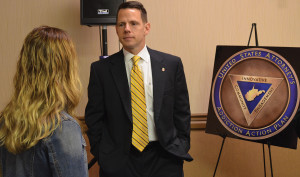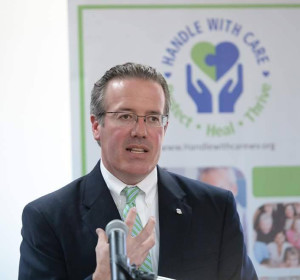West Virginia’s drug epidemic presents a huge challenge to state leaders and community members and a threat to the quality of life in the Mountain State. U.S. Attorney William Ihlenfeld and former U.S. Attorney Booth Goodwin are working together toward a tangible solution.
By Samantha Cart
West Virginia is known for its breathtaking mountains, resilient spirit and hardworking residents. Unfortunately, it is also becoming known for a serious drug epidemic that is affecting not only its most important asset—its people—but its economy, employment rate and legal and court systems.


The drug crisis is complex and poses a serious threat to the quality of life in West Virginia. However, state leaders are working hard to reduce the impact drugs like prescription pills, heroin and methamphetamines are having on the state’s resources. U.S. Attorney for the Northern District of West Virginia William Ihlenfeld and former U.S. Attorney for the Southern District Booth Goodwin are both invested in diminishing the drug supply and demand, advocating for more and better addiction treatment options and reinvigorating the state with a sober, rehabilitated work force.
“When I came into office five and a half years ago, the drug epidemic was one of the most challenging issues my office faced,” says Goodwin. “I figured out very early on that we were not going to be able to arrest our way out of this crisis, and I think that is how we’ve tried to address it in the past. We’re losing people to addiction, and what I think we need to do is help them and give them an opportunity to get better. One of the best antidotes for addiction is getting the person back to work and engaged in positive activities.”
According to the Centers for Disease Control and Prevention, West Virginia leads the nation in drug overdose deaths at 35.5 deaths per every 100,000 residents. While prescription pills continue to cause more deaths than any other category of drugs, the number of heroin-related deaths has skyrocketed in recent years. From 2010-2014, the number of deaths in West Virginia caused by heroin use increased by 385 percent. “The drug crisis involves a wide variety of substances, but heroin has emerged as one of our most significant threats, causing a large number of fatal and non-fatal overdoses,” says Ihlenfeld.
The spike in heroin abuse is closely linked to the decline in the availability of prescription pills. In recent years, law enforcement has made it increasingly difficult to obtain prescription painkillers, leading addicts to pursue heroin, which has a comparable chemical structure and provides a similar high. Heroin is also less expensive and easier to obtain.
Ihlenfeld believes a change in how pain is treated, including more conservative prescribing practices, can significantly change the landscape in the Mountain State. Doctors in West Virginia prescribe narcotic painkillers at the third highest rate in the country, a statistic that has led him to work on the development of guidelines that would call for doctors to prescribe painkillers less often, for shorter durations and in lower doses.
According to Ihlenfeld, a better understanding of what addiction looks like would also pay dividends. “I encourage all West Virginians to try to understand the signs and symptoms of addiction and speak up when they see those symptoms in a friend or loved one,” he says. “Don’t be a bystander and watch someone you know or love self-destruct. Instead, offer help, intervene or, if you are unable to intervene, find someone who can.”
The Northern and Southern districts have each developed successful programs to educate West Virginians on the negative effects of drugs, how to recognize the signs of drug addiction and where to seek treatment. They are working with local and state law enforcement, health care professionals and each other to share information and improve access to resources that will benefit West Virginians struggling with addiction and, in turn, the state overall.

One such collaboration is the U.S. attorneys’ Addiction Action Plan, a multidisciplinary initiative designed by Ihlenfeld to develop innovative, tangible and realistic responses to reduce the regional impact of substance abuse and addiction. The plan brings together a diverse group of leaders from a wide variety of disciplines, including prevention experts, educators, treatment specialists, health care professionals, media members, law enforcement, business leaders and politicians.
Initially launched in Hancock, Brooke and Ohio counties in 2014, the plan was developed to brainstorm ways to reduce the supply of illegal drugs being transported into West Virginia by sharing information, reduce the demand for illegal drugs by enhancing the prevention and education resources available to youth and reduce the social stigma associated with addiction by increasing public awareness.
It has since been implemented in Marion, Monongalia and Harrison counties. One of the key components initiated by the Addiction Action Plan is a procedural change to how overdose incidents are handled. In the past, overdose scenes were handled strictly by medical professionals with little to no follow-up from law enforcement.
According to Ihlenfeld, law enforcement officers in the Northern District are now receiving training on best practices to respond to and investigate drug overdoses. This training includes information on procedures such as securing the crime scene, collecting evidence, conducting interviews and collaborating with local drug task forces. The goal is to identify and arrest the supply source of the drugs that caused the overdose and remove the drugs from the street.
Substance abuse and addiction have far reaching implications, the results of which can be seen across almost all industries and sections of society. A significant challenge for the fight against drug abuse is that data, statistics and numeric quantification reflecting how drug abuse impacts West Virginia are not readily available, and the data that is available is usually several years old. One of the goals of the Addiction Action Plan going forward is to improve the availability, sharing, analysis and utilization of such information.
While the Southern District has a complementary plan, Goodwin’s focus has been on connecting addicts with the resources they need through the Make the Call WV website and app, which works in conjunction with Governor Earl Ray Tomblin’s substance abuse hotline. The site is designed to run a map that attempts to connect people with resources in their area. Goodwin was also involved in promoting an important bill that was passed during the 2015 legislative session, which made naloxone, a medication used to reverse the effects of a drug overdose, more freely available to law enforcement and first responders.
Community Connections, a nonprofit organization in Princeton, WV, is currently hosting a pilot program involving naloxone. The organization received a $100,000 federal grant to make the medication more available in rural areas, including Mercer, McDowell and Wyoming counties. The program allows state police officers in these three counties to carry naloxone so that if they are first on the scene of a drug overdose, they can act rapidly. “Enacting a program like this for an organization the size of the state police force is a logistical and economic issue,” says Goodwin. “This pilot is allowing the state police to see how naloxone can work in a discrete troop so they can learn how to effectively deploy the drug and hopefully later administer it statewide.” Along those same lines, the Make the Call WV app includes an embedded video that shows users how to administer naloxone.

Another initiative Goodwin and Ihlenfeld have worked on together is the Handle with Care program. The program was born out of a study by the U.S. Department of Justice, which found that 60 percent of children have been exposed to a traumatic event in their homes, schools or communities. Handle with Care was first piloted at Mary C. Snow West Side Elementary School in Charleston, WV. If the police encounter a child during a domestic violence call or drug raid, they note the child’s name, age and school. The information is then reported directly to the child’s school so the principals, teachers and nurses are alerted that the child has been exposed to a potentially traumatic event before the child gets to school the next day. This also helps notify teachers as to why a student may not have finished their homework or why they are falling asleep in class or acting out. Handle with Care also offers on-site mental health counseling. Since August 2013, the Charleston Police Department has sent out more than 500 Handle with Care notices and identified approximately 100 children who have witnessed a traumatic event.
“I want to roll this program out statewide and get on-site mental health care in every school in the state,” says Goodwin. “Many, if not all, domestic violence calls and property crimes are directly or indirectly related to the substance abuse crisis we are now facing. It is critical for us to not just fight the issue directly on our hands. We have to make sure we don’t miss the next generation. We have to identify those who have been exposed to substance abuse so we can intervene early and effectively to keep them on the right track.”
The cost of addiction reaches far beyond the devastation and grief it brings to West Virginia families. The epidemic has put a significant strain on the state’s legal and court systems and work force. It has also increased the cost of necessary treatment options; police efforts, investigations and education; incarceration and family services. “Drug use is certainly a burden on our programs, law enforcement and resources, but in my judgment, it is money very well spent,” says Goodwin. “The monetary costs are dwarfed by the social costs of addiction.”
When the numbers and information are all laid out, the drug epidemic seems insurmountable. Between identifying and treating current addicts and educating and preventing people from trying drugs for the first time, West Virginia is facing a huge challenge. “Although the drug epidemic is one of the biggest challenges we face as a state, by taking a comprehensive, community-based approach, we can effectively combat the problem,” says Ihlenfeld. “West Virginians are resilient and will emerge from this storm stronger, safer and healthier.”









4 Responses
The Handle with Care program is a program needed in WV; however, you would think that Booth Goodwin would have picked a reputable mental health agency to participate in the program. The agency Harmony Mental Health aka Harmony Health Services that has been providing therapy at Mary C. Snow since February 2015 was not properly licensed to provide services and was ordered by the WV Health Care Authority, Office of Inspector General to close their facility and to close out their consumers for operating without a license. Upon further investigation, it was discovered that the therapists that were providing therapy to the children at Mary C. Snow were not licensed by WV. Board of Counseling.
Love to help in any way. OxyContin nearly ruined my life years ago because of a defective time-release mechanism. I now have back pain from a car accident but am scared to death to take any pain medicine.
my family has been reeked with drug addictions for years. my children, sibling, friends and friends of my children. i have watched as most have died. young. there are no mental health care facilities that care enough to treat these addicts. i have personly filed mental hygeines, a son that overdosed 12 times in 2 years and on life support each time. recently a daughter was given a needle of meth mixed with bath salts, her mind was so fried she was picked up by an ambulance ,after she had knocked on some peoples doors trying to find out where she was. she was on the block she grew up on. she didn’t know who she was and was a jane doe at the hospital until somehow she remembered my phone number. she didn’t know her 4 children or that she had any. she didn’t know she had 4 siblings. i got a mental comittment . they kept her 9 days. 15 years of addiction and she got 9 days of help. now if she robs someplace to feed this addiction she would get longer jail time, but we all know that is not help. need these addicts in a long term program, not on the streets. the band-aid on this gash is not helping.
This is tied to more than just the drugs themselves. It has to do with economic despair, brutal jobs in coal mines, doctors selling pain medications for the pharmaceutical industry, lousy schools, lack of good mental health and medical clinics, and more. This is a societal result of the corporate colonization of our State which gives tax breaks to the rich and leaves the many in desperation with no money to help. Get the crooks out of our State politics and bring intelligence and compassion to this problem in a holistic way, or these band aides will fail by themselves. This is no accident, it’s a war on West Virginians by those who would rape our mountains, poison our water and devestate our communities while the money goes out of state.